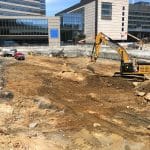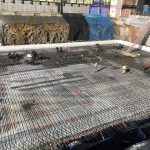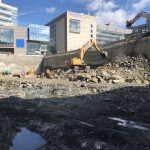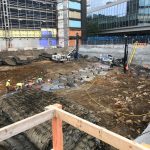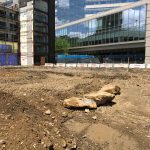Performed design and construction geotechnical, environmental, and geothermal services for this $375 million research building at the UMass Chan Medical School campus.
This nine-story structure included a 30-foot-deep excavation for below grade laboratory space. Performed subsurface exploration program consisting of 13 additional test borings extending to depths of up to 40 feet into bedrock. The excavation consisted of both soil and bedrock which require blasting. Extensive blasting was performed up to a depth of 30 feet below the ground surface as close as 15 feet away from existing structures. The recommended foundation consisted of a 3-foot-thick concrete mat supported entirely upon bedrock. The below-grade portion of the building were designed as a bath-tub type structure and was fully waterproofed to resist hydrostatic pressure. The soil overburden had elevated levels of Arsenic which are typical of the Worcester region and necessitated disposal to a permitted facility. Nobis also contracted, observed, and monitored the installation of a 505-foot-deep geothermal test well including observation of the production wells.
challenges
- Significant rock removal was required for below-grade construction. Blasting to a depth of approximately 30 feet below grade was required to within 15 feet of existing structures. Hospital operations were extremely sensitive to any blasting vibrations.
- Natural levels of Arsenic are notoriously high in the Worcester region and removal of soil from the site was an issue. The on-site soil had high arsenic levels which required specialized off-site disposal.
- The high groundwater table and required below grade construction required special attention to temporary and permanent ground water control.
solutions
- Heavily monitored for vibration (including up to 7 mobile seismographs and three permanently affixed). Lowered peak particle velocity criteria. Blast size, depth and charge was reduced to accommodate. Blasting was a success.
- Off-site disposal of soil with high-levels of Arsenic were transported to a nearby facility permitted to accept the Arsenic-contaminated soil. This resulted in less project cost than shipping soil to a landfill.
- A mat foundation was recommended with full below-grade waterproofing. This consisted of a bathtub-type structure design that ensures the below-grade vivarium space will be completely dry without the need for a permanent dewatering system with pumping.
results
The new research and education facility is scheduled to open in late 2023.
